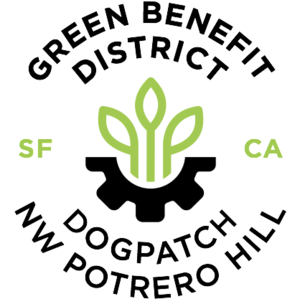Kat: I’m Kat Sawyer, a Greenspace Advocate on the Dogpatch/NW Potrero Hill Green Benefit District Board. I’m here with Terri McFarland, a fellow GBD Director and a landscape architect.
We’re making this video today to support the GBD’s Native Plant Treasure Hunt going on through October on iNaturalist, a citizen science app. You can find more information on how to participate @greenbenefit.org. Press the Treasure Hunt button. There are prizes!
Currently, GBD greenspaces use a mix of non-native and native plants. We have a goal to increase the use of native plants both in public spaces as well as in our neighbor’s backyards.
We’re here in Terri’s backyard in Potrero Hill. Terri, tell us a little about yourself and your passion for native plants.
Terri:
Welcome to my garden in SW Potrero Hill. I’ve been gardening here for 30 years, so I know this space very well. I have planted everything here, including many plants grown from seeds. I’m a Landscape Architect working for 22 years in the Bay Area. I also teach design studios in the Landscape Horticulture department at Merritt College in Oakland. I started a solo design practice in 2018 with a focus on smaller residential projects. I also am an artist, making landscape paintings in oils and watercolors.
Kat:
You’ve got lots of native plants and grasses in your backyard. Can you explain the benefits of native plants?
Terri:
While I use both native and non-native plants in my garden, I’m drawn to native plants because they locate me in the place where I am, in California, in San Francisco, in Potrero Hill. Gardening to me is about being present and aware, and using natives helps to ground me. The plants are adapted for this place, including the current severe drought as in the case of my meadow which currently looks completely dead. I’m perfectly fine with this dormant stage, and in fact, it would be boring to me if my garden didn’t change with the seasons. Here in California, plants go dormant as a strategy for the summer dryness. While I can irrigate to keep my garden greener, I like that my garden doesn’t need it. I have faith that the grasses will green up with the first bit of rain, and that gives me joy.
Kat:
Have you noticed more animal life as a result of planting with natives?
Terri:
Yes, it’s been really fun for me, especially during the pandemic, to watch critters hopping over from my neighbor’s yards to peck at grass seeds, or berries from the California lilac. One of the main reasons we’re looking to encourage native plants in folks’ backyards is that specific pollinators evolve with specific plants. If the plants aren’t there, then neither are the pollinators.
Kat: The concept of including nature in the city is becoming a mainstream idea. Native plants are an important part of that vision. A recent project, the Eco-Patch in NW Potrero is a collaboration with the local chapter of CA Native Plant Society, landscape architects Field Collective, and neighbors with support from the GBD. Can you tell us more about that project?
Terri:
The Eco-Patch is a piece of CalTrans land next to the 101 freeway, which you can hear now in my garden. It’s a garden testing various native plant palettes that might be used here in anyone’s backyard garden. Urban development destroys and fragments native plant populations. They’re pretty much gone. But there are still many pieces of land that can be replanted. Besides private backyards, our neighborhood has a lot of leftover pieces next to the freeway infrastructure. These can be revitalized. There’s a theory from the field of landscape ecology called “patch-corridor-matrix” that can apply to urban landscapes, the idea that small natural patches in people’s backyards can add up to a greater whole, even to create a highly functioning ecosystem within the city. That gives me hope. It’s inspiring to think that pollinators might be able to connect from the Eco-Patch to my garden here hopping along other neighbor’s backyards.
Kat:
How is the landscape architecture profession changing to include native plants?
Terri:
There’s a framework in planting design called “designed plant community.” For new landscapes, the idea is to choose plant palettes based on plant communities that co-exist in natural ecosystems. The Eco-Patch demonstration garden is a great place to see some of these palettes such as Coastal Sage Scrub, or Oak Savannah. You choose plants that go together in the wild ecosystem and put them together your garden. Besides the natural affinity of the plants, you get the added benefit of providing for the pollinators. What’s exciting and hopeful is that many small backyard patches can add up to a bigger system. Flying pollinators don’t see property lines or fences. The idea of what’s beautiful in garden expands to include time, dormancy and the greater environment. And last but not least, I really like being connected to my human neighbors through this adventure.

